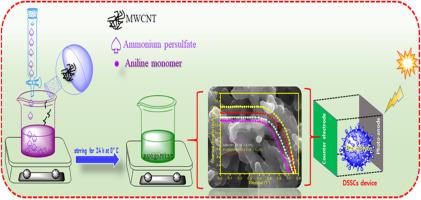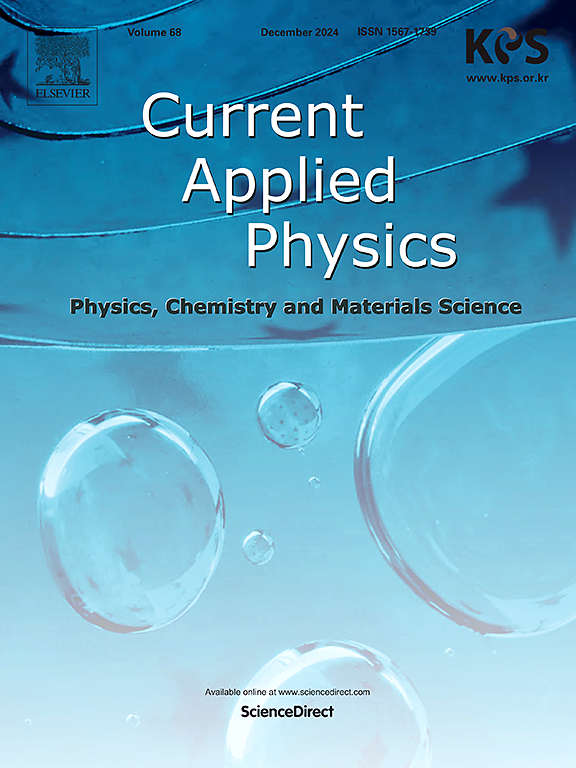Poly(aniline)-multiwall carbon nanotube (PANI@MWCNT) composite as high-cost Pt free counter electrode for dye-sensitized solar cells
IF 2.4
4区 物理与天体物理
Q3 MATERIALS SCIENCE, MULTIDISCIPLINARY
引用次数: 0
Abstract
In this study, we synthesized a poly (aniline)-multiwall carbon nanotube (PANI@MWCNT) composite for use as a counter electrode (CE) in dye-sensitized solar cells. Moreover, FE-SEM and HR-TEM images of PANI@MWCNT revealed carbon nanotube/ropes embedded in the polymer matrix. An X-ray diffraction pattern confirmed the amorphous nature of the composite. Further, Electrochemical impedance spectroscopy studies indicated a charge transport resistance value (Rct) of 4.36 KΩ for PANI@MWCNT. CV studies demonstrated improved electrocatalytic performance and faster redox behavior in the PANI@MWCNT composite. BET analysis measured the pore size of the as-prepared composite to be 15–50 nm. Subsequently, the as-synthesized PANI, PANT@MWNCT, pristine MWCNT, and platinum were evaluated as CEs in DSSCs using a polyethylene oxide polymer-based liquid electrolyte and a TiO2 nanocrystalline photoanode. Among these CEs, the PANI@MWCNT CE exhibited an efficiency of 8.07 %, and the stability test indicated that the as-prepared composite CE retained 7.81 % efficiency after 15 days.

聚(苯胺)-多壁碳纳米管(PANI@MWCNT)复合材料作为染料敏化太阳能电池的高成本无铂对电极
在这项研究中,我们合成了一种聚(苯胺)-多壁碳纳米管(PANI@MWCNT)复合材料,可用作染料敏化太阳能电池的对电极(CE)。此外,PANI@MWCNT 的 FE-SEM 和 HR-TEM 图像显示了聚合物基体中嵌入的碳纳米管/根。X 射线衍射图样证实了该复合材料的无定形性质。此外,电化学阻抗光谱研究表明,PANI@MWCNT 的电荷传输电阻值 (Rct) 为 4.36 KΩ。CV 研究表明,PANI@MWCNT 复合材料的电催化性能得到改善,氧化还原行为更快。BET 分析测得制备的复合材料的孔径为 15-50 nm。随后,使用基于聚环氧乙烷聚合物的液态电解质和 TiO2 纳米晶光电阳极,对合成的 PANI、PANT@MWNCT、原始 MWCNT 和铂作为 DSSC 中的 CE 进行了评估。在这些 CE 中,PANI@MWCNT CE 的效率为 8.07%,稳定性测试表明制备的复合 CE 在 15 天后仍能保持 7.81% 的效率。
本文章由计算机程序翻译,如有差异,请以英文原文为准。
求助全文
约1分钟内获得全文
求助全文
来源期刊

Current Applied Physics
物理-材料科学:综合
CiteScore
4.80
自引率
0.00%
发文量
213
审稿时长
33 days
期刊介绍:
Current Applied Physics (Curr. Appl. Phys.) is a monthly published international journal covering all the fields of applied science investigating the physics of the advanced materials for future applications.
Other areas covered: Experimental and theoretical aspects of advanced materials and devices dealing with synthesis or structural chemistry, physical and electronic properties, photonics, engineering applications, and uniquely pertinent measurement or analytical techniques.
Current Applied Physics, published since 2001, covers physics, chemistry and materials science, including bio-materials, with their engineering aspects. It is a truly interdisciplinary journal opening a forum for scientists of all related fields, a unique point of the journal discriminating it from other worldwide and/or Pacific Rim applied physics journals.
Regular research papers, letters and review articles with contents meeting the scope of the journal will be considered for publication after peer review.
The Journal is owned by the Korean Physical Society.
 求助内容:
求助内容: 应助结果提醒方式:
应助结果提醒方式:


